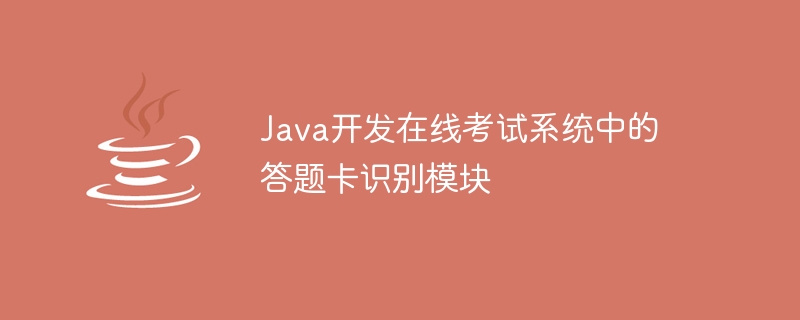

Java develops the answer sheet recognition module in the online examination system
With the popularity of the Internet, online examination systems have become more and more popular. In order to improve the efficiency and accuracy of marking, many online examination systems have begun to introduce answer sheet recognition modules. This module can automatically identify the answers filled in by candidates and store them in digital form for subsequent review and analysis.
The answer sheet recognition module mainly includes two steps: image recognition and answer extraction. First, the answer sheet filled out by the candidate needs to be photographed or scanned into an image. Then, through image recognition technology, the text, images and other contents in the answer sheet are extracted. Next, according to the design rules of the answer sheet, the answers filled in by the candidates are extracted.
In Java development, we can use open source image processing libraries and machine learning libraries to implement the answer card recognition module. Below is a simple example showing how to do answer sheet recognition using Java. .
First, we need to introduce some necessary dependent libraries. In this example, we used JavaCV and Tess4J libraries to implement image recognition and text extraction functions. You can add the following dependencies in the project's pom.xml file:
<dependency>
<groupId>org.bytedeco.javacpp-presets</groupId>
<artifactId>opencv</artifactId>
<version>3.4.1-1.4.1</version>
</dependency>
<dependency>
<groupId>net.sourceforge.tess4j</groupId>
<artifactId>tess4j</artifactId>
<version>4.5.4</version>
</dependency>Next, we create an answer sheet recognition class named AnswerSheetRecognition. In this class, we define a static method named recognize, which is used to recognize the answer sheet and extract the answer:
import org.bytedeco.javacpp.opencv_core.Mat;
import org.bytedeco.javacpp.opencv_core.Rect;
import org.bytedeco.javacpp.opencv_core.Size;
import org.bytedeco.javacpp.opencv_imgproc;
import org.bytedeco.javacv.Java2DFrameConverter;
import org.bytedeco.javacv.OpenCVFrameConverter;
import org.bytedeco.javacv.CanvasFrame;
import org.bytedeco.javacv.Frame;
import org.bytedeco.javacv.FrameGrabber;
import org.bytedeco.javacv.FrameRecorder;
import javax.imageio.ImageIO;
import java.awt.image.BufferedImage;
import java.io.File;
import java.io.IOException;
import net.sourceforge.tess4j.Tesseract;
import net.sourceforge.tess4j.TesseractException;
public class AnswerSheetRecognition {
public static void recognize(String imagePath) throws IOException, TesseractException, FrameGrabber.Exception, FrameRecorder.Exception {
// 加载答题卡图像
File imageFile = new File(imagePath);
BufferedImage image = ImageIO.read(imageFile);
// 创建OpenCV的图像对象
OpenCVFrameConverter.ToIplImage converter = new OpenCVFrameConverter.ToIplImage();
Frame frame = converter.convert(image);
// 将图像转换为灰度图
opencv_imgproc.cvCvtColor(converter.convert(frame), frame, opencv_imgproc.CV_BGR2GRAY);
// 图像增强
opencv_imgproc.GaussianBlur(frame, frame, new Size(5, 5), 0);
// 二值化处理
opencv_imgproc.adaptiveThreshold(frame, frame, 255, opencv_imgproc.CV_ADAPTIVE_THRESH_MEAN_C, opencv_imgproc.CV_THRESH_BINARY_INV, 7, 10);
// 填充答题卡选项
opencv_imgproc.floodFill(frame, new Rect(0, 0, 10, 10), 0.0);
// 执行OCR识别
Tesseract tess = new Tesseract();
String recognizedText = tess.doOCR(converter.convert(frame));
// 输出识别结果
System.out.println(recognizedText);
}
public static void main(String[] args) throws Exception {
String imagePath = "path_to_your_image";
recognize(imagePath);
}
}In this code, we first load the answer sheet image, and then use the OpenCV library to Images are processed. We used grayscale, image enhancement, binarization and other methods to better extract the text on the answer sheet. Next, we use the Tesseract library to perform OCR recognition of the text in the answer sheet. Finally, we output the recognition results to the console.
Of course, this is just a simple example. In practice, you may need to perform more detailed processing based on the design rules and requirements of the answer sheet. In addition to image processing and text recognition, steps such as option extraction and answer matching may also be required.
In short, the answer card recognition module plays an important role in the online examination system developed in Java. By leveraging open source libraries and machine learning technology, we can easily implement the image recognition and answer extraction functions of answer sheets, thereby improving the efficiency and accuracy of marking. I hope this example has inspired you, and I wish you successful development!
The above is the detailed content of Java develops answer card recognition module in online examination system. For more information, please follow other related articles on the PHP Chinese website!
 What drawing software are there?
What drawing software are there?
 Recommended order for learning c++ and c language
Recommended order for learning c++ and c language
 How to withdraw money on WeChat without handling fees
How to withdraw money on WeChat without handling fees
 The performance of microcomputers mainly depends on
The performance of microcomputers mainly depends on
 How to use jsp programming software
How to use jsp programming software
 The Metaverse recognizes the top ten potential coins
The Metaverse recognizes the top ten potential coins
 How to delete a folder in linux
How to delete a folder in linux
 What to do if 302 found
What to do if 302 found
 what is ed
what is ed




